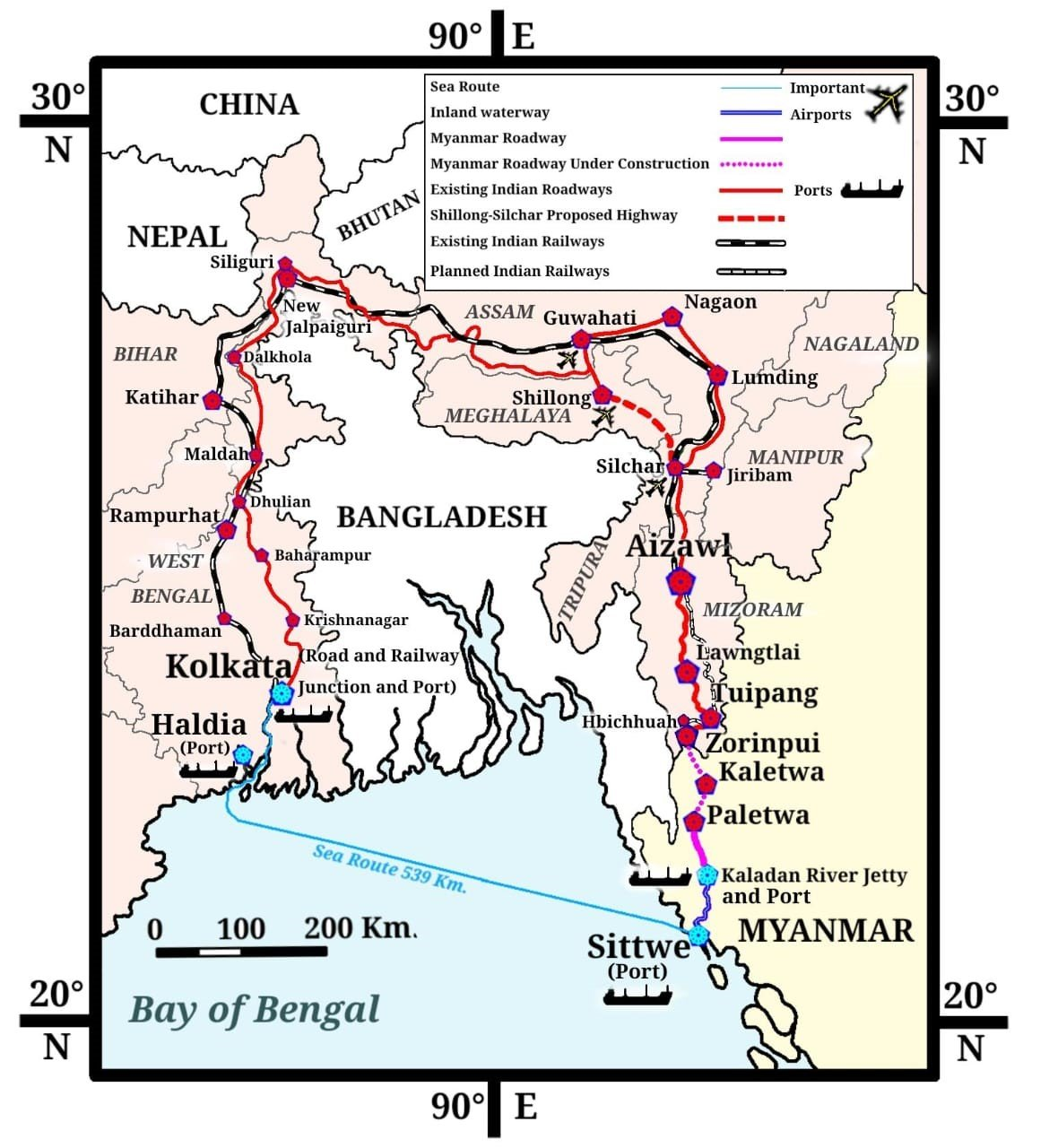Font size:
Print
Shillong–Silchar Corridor & Kaladan Route
Rewiring India’s Neighbourhood Diplomacy
Context: While geographic proximity often encourages collaboration between states, it can’t replace strategic diplomacy—especially when geopolitical conditions turn adverse.

More on News
- India’s recent approval of a greenfield high-speed Shillong–Silchar Corridor reflects this strategic shift.
- Spanning 166.8 km with a budget of ₹22,864 crore, the corridor will connect Mawlyngkhung (Meghalaya) with Panchgram (Assam) by 2030, featuring 19 major bridges, 153 minor bridges, 326 culverts, 22 underpasses, 26 overpasses, and 34 viaducts.
Boosting Intra-Northeast connectivity
- Travel time between Shillong and Silchar reduced from 8.5 to just 5 hours.
- Industrial stimulus expected by passing through Meghalaya’s coal & cement regions.
- Aligns with the PM Gati Shakti Master Plan (2021) for multimodal infrastructure.
- Enhances access to Guwahati, Shillong, and Silchar airports.
- The corridor also has geo-strategic potential, offering an alternative route to the Bay of Bengal through Myanmar—bypassing reliance on Bangladesh.
Evolving ties with Bangladesh
- Bangladesh shares a 4,096 km border with India and has historically been the main transit route for Northeast exports via Chattogram and Mongla ports.
- These ties strengthened in the last decade under the Awami League.
- However, the recent government shift in Dhaka has introduced uncertainties.
- Of particular concern is Bangladesh’s consideration of a Chinese airbase near the Siliguri Corridor and strategic statements by its leaders, challenging India’s traditional geographic advantage.
- This prompted India to suspend Bangladesh’s transit privileges, signalling the Northeast’s strategic value and the impact of diplomatic tensions on neighboring states like Nepal and Bhutan.
Andaman Plan B: A corridor via Myanmar
In response, India is pivoting eastward, bolstering connections through Myanmar with the ongoing:
- India–Myanmar–Thailand (IMT) Trilateral Highway, and
- Kaladan Multimodal Transit Transport Project (KMMTTP) — linking Sittwe Port to Paletwa and onward to Zorinpui (Mizoram).
- Notably, Sittwe Port began operations in May 2023 and was taken over by India in April 2024, handling over 150 vessels.
- Yet security instability in Myanmar’s Rakhine State threatens progress.
- Projects are underway to complete the remaining 110 km road section via Ircon International, though challenges like land disputes and insurgencies persist.
Strategic synergy: Shillong–Silchar x Kaladan Corridor
By integrating the Shillong–Silchar Corridor with Kaladan’s multimodal network, India plans a seamless transport chain:
- Ship cargo from Kolkata → Sittwe → Paletwa → Zorinpui → Mizoram → Silchar → broader Northeast region.
- This route enhances supply chain resilience amid geopolitical volatility and supports India’s Act East initiative.
- It also counters rising Chinese influence—such as the proposed China–Myanmar Economic Corridor (CMEC).
Balancing strategy with community resilience
- Geopolitical pressures and conflict risks underscore the importance of local community engagement, equitable benefit-sharing, and prioritising stakeholder trust.
- Such integration not only secures infrastructure but also fosters social stability in conflict-sensitive zones.
Key Takeaway: A region turned gateway
India’s twin initiatives—the Shillong–Silchar Corridor and the Kaladan multimodal route—demonstrate a recalibrated strategy that:
- Reduces Bangladesh dependency,
- Diversifies connectivity pathways, and
- Strengthens the Northeast as a strategic gateway in the Indo-Pacific region.
This approach reflects India’s nuanced balance of economic planning, regional diplomacy, and long-term security goals.


